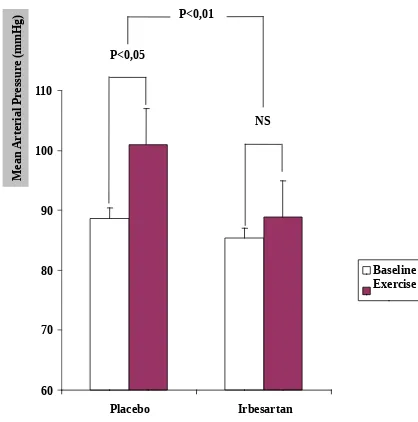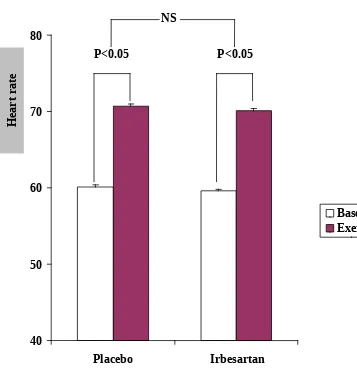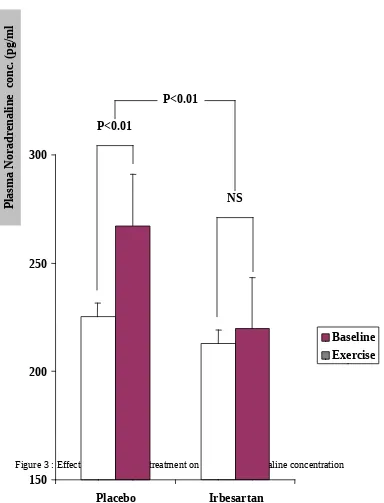The Effects Of Irbesartan on Sympathetic Activity in Humans
Rahmatina B Herman
Faculty of Medicine, University of Andalas, Indonesia
Diterima tanggal : 21 Juli 2006 disetujui : 05 September 2006
Abstract
In experimental settings, angiotensin II has been reported to interact with the sympathetic nervous system both centrally and peripherally. Direct evidence for this mechanism is limited in humans. We have examined the effect of AT1 receptor blockade on plasma noradrenaline during isometric handgrip exercise in healthy young volunteers. This study investigated the effects of five days pretreatment with 150mg/day irbesartan, a selective AT1-receptor antagonist on plasma noradrenaline during isometric handgrip exercise in nine healthy male volunteers (mean age 24.4 0.2 (SD) years) in a double blind randomized crossover study. A match placebo was given to control group. The results showed that irbesartan did not affect resting haemodynamic and plasma noradrenaline levels. However, irbesartan pretreatment blunted the increase in plasma noradrenaline during exercise (placebo, from 225.3 19.6 to 267.2 16.4 pg/ml; irbesartan, from 212.9 15.8 to 219.8 15.1 pg/ml; irbesartan vs placebo, p<0.01). Irbesartan pretreatment also blunted the increase in mean arterial pressure during exercise (placebo, from 88.6 2.8 to 100.9 4.0 mmHg; irbesartan, from 85.4 3.1 to 88.9 3.4 mmHg; irbesartan vs placebo, p<0.01). These data indicated a beneficial effect of AT1-blocker
on sympathetic activity during the stimulus of isometric handgrip exercise in humans.
Keywords: AT1-blockade, noradrenaline, sympathetic activity
Introduction
The development and successful application of angiotensin II receptor antagonist therapy for congestive heart failure has focused attention on the role of angiotensin II in circulatory control in this disease. In experimental settings, angiotensin II has been reported to interact with the sympathetic nervous system both centrally and peripherally. It is widely known that there exist the interaction between renin-angiotensin system (RAS) and sympathetic nervous system (SNS) at some levels. Angiotensin II has been shown to act on the sympathetic nervous system at the level of brain and medulla (Campbell, 1989) and to modulate the arterial baroreflex through a central action (Guo, 1984). Angiotensin II has also been proven to enhance noradrenaline biosynthesis in the adrenergic nerve terminal (Boadle, 1969), facilitate noradrenaline release (Starke, 1977), inhibit the reuptake of noradrenaline from sympathetic nerve terminals (Khairallah, 1972; Palaic, 1967) and potentiate the postsynaptic responsiveness to noradrenaline (Lang, 1993; Seidelin , 1987; Zimmerman, 1984). In addition, angiotensin II can elicit noradrenaline release from the chromaffin tissue (Bernier, 1977). Angiotensin II facilitates the exocytotic release of noradrenaline from the presynaptic sympathetic varicosities, acting through AT1 receptors (Brasch, 1993). Thus, inhibition by
AT1 receptor-blocker would be expected to lead to a
decrease in the release of noradrenaline.
Moreover, as an AT1-inhibitor, irbesartan has no
effect on bradykinin and prostaglandin (Gillis, 1997). This is an important benefit of AT1
-inhibitors, because, bradykinin causes the local release of neuropeptides such as Substance P, which stimulate specific receptors on sympathetic nerve terminals and thus release noradrenaline (Seyedi, 1999).
It is hypothesized that the more complete blockade of angiotensin II effects and lack of effect on bradykinin may completely suppress catecholamines. To test this hypothesis we have examined the release of noradrenaline during isometric handgrip exercise in healthy young volunteers. In this study we investigated the ability of AT1-blocking, with irbesartan, to modulate
sympathetic activity both at rest and during isometric handgrip exercise.
Methods
Nine healthy, normotensive male subjects (mean age 24.4 0.2 years) were studied. Medical history, physical examination, and electrocardiogram established that each subject was free of clinically significant abnormalities. Subjects did not take any medication for at least two weeks before and throughout the duration of the study. All subjects gave written informed consent to the study protocol, which had been approved by the local ethics committee.
Study Design
The study was designed as a double blind within subject placebo controlled trial. Subjects were randomized to receive either irbesartan 150mg/day (Approvel, Sanofi-Synthelabo, FR) or matched placebo for five days. The study consisted of two study limbs with at least one week between each investigational day. So that, in each study limb there was five study days with the investigational day on the fifth day.
Each volunteer was asked to adhere to his customary diet for the duration of the study and to maintain a similar pattern of meals for the 24–48h before each investigational day. Sodium intake was not strictly controlled and his sodium status was assessed by estimation of 24h urinary sodium excretion. Alcohol was prohibited over the previous 36h of the investigational day. Cigarette smoking and caffeine containing drinks such as tea, coffee, chocolate, coca-cola were prohibited on the morning of the investigational day.
All studies were performed on the morning of the fifth day of each study limb after an overnight fast, with the subjects resting in a sitting position in a quiet room in the Clinical Investigation Center. An intravenous cannula was placed in the antecubital fossa of left arm for drawing blood samples. They were instructed to swallow the last tablet of either irbersartan or placebo, depending on their randomization.
At 10.40 AM pretest blood pressure and heart rate were recorded using a semi-automatic sphygmomanometer (Colin Corporation, Tokyo, Japan) and blood samples were drawn for determination of pre-exercise noradrenaline. Subjects were then asked to perform isometric handgrip exercise with squeezing a dynamometer to gauge strength of 30% of predetermined voluntary maximal contraction for three minutes. They were instructed to count aloud to avoid a Valsalva maneuver. Blood pressure and heart rate were recorded 2 minutes into the exercise and venous
blood samples were drawn again from the exercising arm at 2 minutes and 45 seconds.
Blood collection and analysis
Blood samples were collected into vaccutainer tubes containing lithium heparin as anticoagulant for measurement of plasma noradrenaline. Blood samples were placed immediately in ice-cold box and transported to laboratory. Blood samples were then centrifuged at 3000 rpm at 4C for 5 minutes. Plasma were separated and stored at -70C till analysis.
Plasma noradrenaline was measured by a Gas Chromatography – Mass Spectrometer (Shimadzu, Japan) as previously described (Herman, 1999). The intra-assay coefficient of variation was 4.07% and the inter-assay coefficient of variation was 3.31%. The lower limit of detection of the assay was 100pg/ml. 24-hr urinary sodium excretion was measured by the Quiklyte integrated multisensor (Quiklyte, Dade Behring Inc, Newark, USA). The intra-day coefficient of variation was 0.65%; the inter-day coefficient of variation was 0.76%.
Statistical analysis
Data were managed and analyzed using the SPSS program. All values are presented as mean SD. The statistical significance of the differences was evaluated with two tailed Student’s t test for paired and unpaired values; p values of less than 0.05 were considered as statistically significant.
Results
None of the volunteers had abnormalities in cardiovascular examination and in haemodynamic measurement at baseline. Twenty four hours sodium excretions were not significantly different between placebo and irbesartan pretreatment, p>0.1 (Table 1).
Effects of irbesartan on resting haemodynamic and resting plasma noradrenaline concentration
Irbesartan pretreatment did not significantly alter resting haemodynamic and resting plasma noradrenaline concentration (p>0.1) (Table 1).
p<0.01 (Figure 1). However, there was no significant differences between placebo and irbesartan pretreatment in the increase in heart rate induced by isometric handgrip exercise ((placebo, from 60.1 3.7 beats/min to 70.7 4.1 beats/ min (p<0.05); irbesartan, from 59.6 3.3 beats/min to 70.1 2.9 beats/min (p<0.05); and placebo compared to irbesartan p>0.1) (Figure 2).
The increase in plasma noradrenaline concentration induced by isometric handgrip exercise was also significantly blunted by irbesartan pretreatment (from 212.9 15.8 pg/ml to 219.8 15.1 pg/ml (p>0.1)); compared to placebo (from 225.3 19.6 pg/ml to 267.2 16.4 pg/ml (p<0.01)); and irbesartan vs placebo, p<0.01 (Figure 3).
Discussion
A number of studies reported that angiotensin II is capable of interacting with the sympathetic nervous system at various levels. In anaesthetized animals, some studies shown a facilitatory effect of endogenous angiotensin II on renal and total noradrenaline overflow (Majewski, 1984; Hayashi, 1991; Stead, 1990} although this is not a universal finding (Platzack, 1995; Doward, 1991). In humans, most early studies focused on the effects of exogenously administered angiotensin II. Seidelin et al suggest that there is a pharmacodynamic interaction between noradrenaline and angiotensin II which acts synergistically at a postsynaptic site to maintain systolic blood pressure. Webb et al (Webb, 1988) have shown that intrabrachial artery infusion of subpressor doses of angiotensin II augmented the sympathetically mediated vasoconstriction induced by lower body negative pressure. This study was suggested a pre-junctional effect, because there was no change in forearm blood flow with angiotensin II infusion alone and the vasoconstrictor effect of intra-arterial noradrenaline was not enhanced by co-administration of angiotensin II. Another study (Clemson, 1994) demonstrated an increased forearm venous noradrenaline and forearm noradrenaline spillover when angiotensin II was infused intra-arterially during lower body negative pressure, which supporting a previous study by Taddei et al (Taddei, 1991) in hypertensive individuals. However, Goldsmith et al (Goldsmith, 1993; Goldsmith, 1990) failed to find that angiotensin II facilitated noradrenaline release in intravenous infusion of angiotensin II during rest or 60-degree upright tilt in normal subjects and in patients with heart failure.
Lang et al (Lang, 1997) showed that an angiotensin converting enzyme (ACE) inhibitor, captopril, did not blunt SNS activity and suggested that the lack effect of ACE inhibitor likely related to the effect of bradykinin. ACE inhibitors have been reported to increase circulating bradykinin (Johnston, 1982). Bradykinin causes the local release of neuropeptides, such as Substance P, which stimulate specific receptors on sympathetic nerve terminals and thus release noradrenaline. The important benefit of irbesartan as an AT1-inhibitor,
that it has no effect on bradykinin and prostaglandin (Gillis, 1997).
The present study was designed to administer five days pretreatment with irbesartan, an AT1-selective
inhibitor, allowing the effects of AT1-blockade on
neurotransmission to be defined (Dzau, 1988).
We found that irbesartan pretreatment did not alter resting haemodynamic parameters and resting plasma noradrenaline. However, irbesartan pretreatment significantly blunted the increase in mean arterial pressure and plasma noradrenaline induced by isometric handgrip exercise. It means that irbesartan may inhibit the release of norepinephrine from presynaptic terminals of sympathetic nervous system which induced by isometric handgrip exercise with the additional effect the decrease in mean arterial pressure. The effects of irbesartan are through the inhibition of angiotensin II. As described that there exist the interaction between renin-angiotensin system (RAS) and sympathetic nervous system (SNS) at some levels. Angiotensin II has been shown to act on the sympathetic nervous system at the level of brain and medulla (Campbell, 1989) and to modulate the arterial baroreflex through a central action (Guo, 1984). Angiotensin II has also been proven to enhance noradrenaline biosynthesis (Boadle, 1969), facilitates the release of noradrenaline (Starke, 1977; Bernier, 1997), inhibit the reuptake of noradrenaline from sympathetic nerve terminals (Khairallah , 1972; Palaic, 1967) and potentiate the postsynaptic responsiveness to noradrenaline (Lang , 1993; Seidelin , 1987, Zimmerman, 1984); it acting through AT1-receptors
Brasch, 1993).
the sympathetic nervous system (SNS) at presynaptic site in man and that selective blockade of AT1-receptors has the beneficial effects of suppressing sympathetic activity.
Conclusion
We have demonstrated a potential effect of irbesartan, a specific AT1-blocker on sympathetic
activity in humans. Irbesartan pretreatment significantly blunted the increase in mean arterial pressure and plasma noradrenaline during isometric handgrip exercise. We conclude that our results support the notion that there exist an important interaction between the renin-angiotensin system and the sympathetic nervous system at presynaptic site in man. Our results also support that more complete blockade of angiotensin II effects and lack of effect on bradykinin may completely suppress the release of noradrenaline.
Acknowledgments
I wish to express my gratitude to Prof. CC Lang, Prof. Ruby Husain, and Prof. Mustafa for their valuable suggestions and guidance, and for Mr. V.T. Johgalingam, Mr. K.S. Chua, Ms. G.Y. Christina and Mr. Y.P. Voo for their valuable technical assistance. This study was funded by an IRPA grant from The Ministry of Science, Technology and The Environment, Malaysia.
References
Bernier N.J., and Perry S.F., 1997, Angiotensins stimulate catecholamine release from the chromaffin tissue of the rainbow trout, Am. J. Physiol., 273, R49 – R57.
Brasch H., Sieroslawski L., and Dominiak P., 1993, Angiotensin II increases norepinephrine release from atria by acting on angiotensin subtype 1 receptors, Hypertension, 22, 699 – 704.
Boadle M.C., Hughes J., and Roth R.H., 1969, Angiotensin accelerates catecholamine biosynthesis in sympathetically innervated tissue, Nature, 222, 987 – 988.
Campbell D.J., 1989, Extrarenal renin and blood pressure regulation: an alternative viewpoint, Am. J. Hypertens., 2, 266 – 275.
Clemson B., Gaul L., Gubin S.S., Campsey D.M., McConville J., and Nussberger J., 1994, Prejunctional angiotensin II
receptor: facilitation of norepinephrine release in human forearm, J. Clin. Invest., 93, 684 – 691.
Doward P.K., and Rudd C.D., 1991, Influence of brain renin angiotensin system on renal sympathetic and cardiac baroreflexes in conscious rabbits, Am. J. Physiol., 260, H770 – H778.
Dzau V.J., 1988, Circulating versus local renin-angiotensin systems in cardiovascular homeostasis, Circulation, 77 (suppl), I4 – I13.
Guo G.B., and Abboud F.M., 1984, Angiotensin II attenuates baroreflex control of heart rate and sympathetic activity, Am. J. Physiol., 246, H80 – H89.
Gillis J.C., and Markham A. 1997, Irbesartan. A review of its pharmacodynamic and pharmacokinetic properties and therapeutic use in the management of hypertension, Drugs, 54, 885 – 902.
Goldsmith S.R., Haskings G.J., and Miller R.N., 1993, Angiotensin II and sympathetic activity in patients with congestive heart failure, J. Am. Coll. Cardiol., 21, 1107 – 1113.
Goldsmith S.R., and Haskings G.J., 1990, Subpressor angiotensin II infusions do not stimulate sympathetic activity in humans, Am. J. Physiol., 258, H179 – H182.
Herman R.B., Mustafa A.M., Husain R., Choy A.M., and Lang C.C., 1999, Assessment of picogram concentration of plasma norepinephrine using gas chromatograph-mass spectrometer (GCMS), Abstracts of Joint 14th Scientific Meeting of the Malaysian Society of Pharmacology and Physiology - Cardiac Rehabilitation Conference and Cardiovascular Counselling Workshop, Penang, Malaysia.
Johnston C.I., Clappison B.H., Anderson W.P., and Yasujima M., 1982, Effect of angiotensin converting enzyme inhibition on circulating and local kinin levels, A. J. Cardiol., 49, 1401 – 1404.
Khairallah P.A., 1972, Action of angiotensin on adrenergic nerve endings: inhibition of norepinephrine uptake, Fed. Proc., 31, 1351 – 1357.
Lang C.C., Rahman A.R., Balfour D.J.K., and Struthers A.D., 1993, Enalapril blunts the antinatriuretic effects of circulating noradrenaline in man, J. Hypertens., 11, 565 – 572.
Lang C.C., Rayos G.H., Chomsky D.B., Wood A.J.J., and Wilson J.R., 1997, Effect of sympathoinhibition on exercise performance in patients with heart failure, Circulation, 96, 238 – 245.
Majewski H., Hedler L., Schurr C., and Starke K., 1984, Modulation of noradrenaline release in the pithed rabbit: a role for angiotensin II, J. Cardiovasc. Pharmacol., 6, 888-896.
Palaic D., and Khairallah P.A., 1967, Inhibition of noradrenaline uptake by angiotensin, J. Pharm. Pharmacol., 19, 396 – 397.
Platzack B., 1995, Blood pressure control by the renin-angiotensin system and its interaction with the sympathetic nervous system in fish, Braz. J. Med. Biol. Res., 28, 1227 – 1231.
Rodriguez-Garcia J.L., Paule A., Dominguez J., Garcia-Escribano J.R., and Vazquez M., 1999, Effects of the angiotensin II antagonist losartan on endothelin-1 and norepinephrine plasma levels during cold pressor test in patients with chronic heart failure, Int. J .Cardiol., 70, 293 – 301
Seyedi N., Maruyama R., and Levi R., 1999, Bradykinin activates a cross-signaling pathway between sensory and adrenergic nerve endings in the heart. A novel mechanism of ischemic norepinephrine release?, J. Pharmacol. Exp. Ther., 290, 656 – 663.
Seidelin P.H., Coutie W.J., Pai M.S., Morton J.J., and Struthers A.D., 1987, The interaction between noradrenaline and angiotensin II in man: evidence for a postsynaptic and against a presynaptic interaction, J. Hypertens., 5 (suppl), S121 – S124.
Starke K., 1977, Regulation of noradrenaline release by presynaptic receptor systems, Rev. Physiol. Biochem. Pharmacol, 18, 27 – 30.
Stead S.W., and Bloor B.L., 1990, The effects of captopril on the renin-angiotensin system and the sympathetic nervous system during sodium nitroprusside-induced hypotension in the halothane-anesthetized rabbit, J. Cardiovasc. Pharmacol., 15, 968 – 975.
Taddei S., Favilla S., Duranti P., Simonini N., and Salvetti A., 1991, Vascular renin-angiotensin system and neurotransmission in hypertensive persons, Hypertension, 18, 266 – 277.
Webb D.J., Seidelin P.H., Benjamin N., Gillier J.G., and Struthers A.D., 1988, Sympathetically mediated vasoconstriction is augmented by angiotensin II in man, J. Hypertens., 6 (suppl), S542 – S543.
[image:5.595.103.500.675.754.2]Zimmerman B.G., Sybertz E.J., and Wong P.C., 1984, Interaction between sympathetic and renin-angiotensin system, J. Hypertens., 2, 581 – 587.
Table 1. 24h urinary sodium excretion and baseline data of haemodynamic and plasma noradrenaline concentration
Placebo Irbesartan 24h urinary sodium excretion (mol/min)
Mean arterial pressure (mmHg) Heart rate (beats per minute)
Plasma noradrenaline concentration (pg/ml)
101.4 14.0 88.6 2.8 60.1 3.7 225.3 19.6
Footnote: Results are expressed as mean SEM;
[image:6.595.87.505.177.599.2]No significant differences were found at baseline between the two groups.
Figure 1 : Effect of irbesartan on mean arterial pressure response to isometric handgrip exercise
60
70
80
90
100
110
Placebo
Irbesartan
Baseline
Exercise
P<0,05
P<0,01
NS
M
ea
n
A
rt
er
ia
l P
re
ss
u
re
(
m
m
H
Figure 2 : Effect of irbesartan pretreatment on heart rate response to isometric handgrip exercise
40
50
60
70
80
Placebo
Irbesartan
Baseline
Exercise
H
ea
rt
r
at
e
P<0.05
P<0.05
Figure 3 : Effect of irbesartan pretreatment on plasma noradrenaline concentration
150
200
250
300
Placebo
Irbesartan
Baseline
Exercise
P
la
sm
a
N
or
ad
re
na
li
n
e
c
on
c.
(
p
g/
m
l
P<0.01
P<0.01



